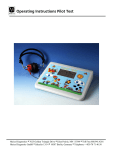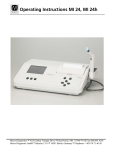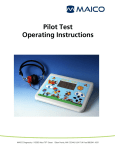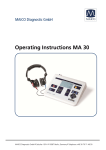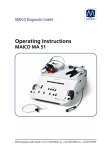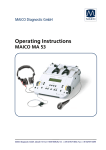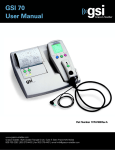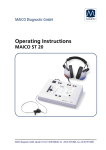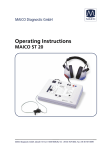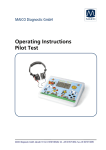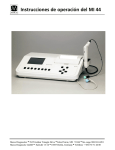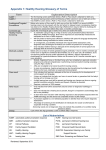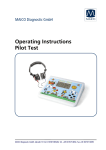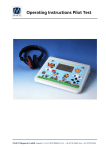Download Operating Instructions Detective Audiometer
Transcript
Operating Instructions Detective Audiometer Maico Diagnosticsi7625 Golden Triangle DriveiEden Prairie, MN 55344iToll Free 888.941.4201 Maico Diagnostic GmbHiSalzufer 13/14i10587 Berlin, GermanyiTelephone ++030 70 71 46 50 Operating Instructions Detective Audiometer TABLE OF CONTENTS WARRANTY ................................................................................................................................... 1 1 Instrument description................................................................................................................. 2 2 Unpacking and inspection ........................................................................................................... 3 2.1 External inspection .............................................................................................................. 3 2.2 Unpacking........................................................................................................................... 3 3 Installation and setup ................................................................................................................. 4 3.1 Where to set up .................................................................................................................. 4 3.2 How to set up ..................................................................................................................... 4 3.3 Calibrating the device.......................................................................................................... 4 3.4 Display and control panel .................................................................................................... 5 4 Basics related to hearing disorders .............................................................................................. 6 4.1 Hearing disorders ................................................................................................................ 6 4.2 Incidence of hearing loss ..................................................................................................... 7 5 Performing the test .................................................................................................................... 8 5.1 Preparing the child .............................................................................................................. 8 5.2 Testing ................................................................................................................................ 8 5.3 Error Messages.................................................................................................................. 10 5.4 Evaluation of the test ........................................................................................................ 10 5.5 Changing the voice prompt language................................................................................ 11 6 Performing Manual pure-tone tests .......................................................................................... 12 6.1 Changing from an automatic to a manual test................................................................... 12 6.2 Testing in manual mode .................................................................................................... 12 6.3 Switching ears................................................................................................................... 13 6.4 Evaluation of the test results.............................................................................................. 13 7 Set up the Detective Audiometer for your individual needs ....................................................... 14 8 Care and maintenance of the instrument.................................................................................. 17 9 Technical data and accessories.................................................................................................. 18 10 Troubleshooting ..................................................................................................................... 20 11 After-sales service and calibration ........................................................................................... 21 11.1 After-sales service............................................................................................................ 21 11.2 Calibration ...................................................................................................................... 21 11.3 Shipping instructions for calibration and repair ................................................................ 22 12 Safety regulations................................................................................................................... 23 i Operating Instructions Detective Audiometer 13 Thermal printer set-up………………………………………………………………………………. 24 13.1 Description of the unit...…………………………………………………………..……..…... 24 13.2 Safety warnings……......…………………………………………………………..…….….... 26 13.3 Installation……………...…………………………………………………………..…….……. 26 14 Using the thermal printer………………………………………………………………………….... 27 14.1 Turning the printer on and off.……………………………………………………..……….. 27 14.2 Inserting paper into the printer……….…………………………………………..…….……. 27 14.3 Removing paper from the printer……………………………………………..…….…......... 27 14.4 Paper feed……………...…………………………………………………………..…….….... 28 14.5 Self-test….……………...…………………………………………………………..…….…… 28 14.6 Printing……………...…………………………………………………………..…….……..... 29 14.7 Cleaning……………...…………………………………………………………..…….……… 29 14.8 Troubleshooting…...…………………………………………………………..…….….......... 30 14.8.1 LED Indications...…………………………………………………………..…….…........ 30 14.8.2 Problem-solving...…………………………………………………………..…….…....... 30 14.9 Spare parts list………………………………………………………………………………..... 31 ii Operating Instructions Detective Audiometer WARRANTY This warranty is extended to the original purchaser of the Detective Audiometer, through the authorized Special Instrument Distributor from whom it was purchased. This warranty covers defects in material and workmanship for a period of one year from date of delivery of the Detective. Should the Detective Audiometer require service due to a defect in material or workmanship, Maico, at its option, will repair or replace the instrument at no charge except for transportation to and from the point of service. It is the purchaser’s responsibility to return the Detective Audiometer to the Maico Special Instrument Distributor from whom it was purchased or directly to Maico after receiving a return authorization. This warranty does not cover breakage or failure caused by tampering, misuse, carelessness, accident or modification. The warranty is void if the instrument is serviced by other than an authorized Maico Special Instrument Service Center. NOTE: Specifications in this manual are in effect at the time of printing. Maico reserves the right to modify or change specifications or design at any time without notice or incurring obligation. WARNING: The Detective Audiometer is designed to be used with a hospital grade outlet. Injury to personnel or damage to equipment can result when a three-prong to two-prong adapter is connected between the power plug and an AC outlet or extension cord. 1 Operating Instructions Detective Audiometer 1 Instrument description Our products are designed to put children at ease, allowing you to make a diagnosis quickly, easily and accurately. The Detective audiometer is intended for use with school age children in order to quickly screen for a hearing loss or establish an air-conduction threshold. The Detective Audiometer has both a manual pure-tone audiometer as well as automatic audiometry function for older children. This allows accurate screening of more mature children, while allowing the tester time to attend to other tasks during the test, such as filling out necessary paperwork or screening documentation. 2 Operating Instructions Detective Audiometer 2 Unpacking and inspection 2.1 External inspection Your Detective Audiometer was carefully inspected and packed for shipping. However, it is good practice to thoroughly inspect the outside of the shipping container for signs of damage. If any damage is noted, please notify the carrier immediately. 2.2 Unpacking Remove the upper layer of packing material from the top of the instrument. Carefully lift the instrument from the shipping carton and remove the plastic bag. Inspect the case for signs of any damage. Notify the carrier immediately if any signs of mechanical or physical damage are found will ensure that a proper claim is made. Save all packing materials so that the claim adjuster can inspect them as well. When the adjuster has completed the inspection, notify your Maico Special Instrument Distributor. Save all the original packing materials and the shipping carton so the instrument can be properly packaged if it needs to be returned for service or calibration. Open the box containing the Detective Audiometer and check to see that you have the following items: • Detective Audiometer • Detective Audiometer AC power cord • Printer • Printer AC power supply • Printer AC power supply cord • Printer cable • Printer paper (1 roll) • TDH-39 headset • Patient response switch • Operating manual with warranty card • Calibration certificate A carrying case is also available for your Detective. If you haven’t purchased a carrying case, be sure to save the box your unit came in. It has been specially designed to protect it during transportation. Please check that all items listed above are received in good condition. If any items are missing or damaged, immediately notify your Maico Special Instrument Distributor. 3 Operating Instructions Detective Audiometer 3 Installation and setup 3.1 Where to set up A quiet room furnished with a desk or table is ideal for using the Detective Audiometer. If a separate room is not available, try to locate an area with minimal noise and distractions. Remember: background or ambient noise can distract the child and affect the results of the test. Electro-medical instruments emit strong electromagnetic fields (e.g., microwave-radiotherapy devices) which can influence the function of this device. Therefore, do not use those types of instruments in close proximity to the Detective Audiometer. The test room should be at normal room temperature (15º C/59º F to 35º C/95º F), and the instrument should be turned on about 10 minutes before the first measurement. 3.2 How to set up Setup is accomplished in four easy steps: 1. Plug the power cord into the rear panel. 2. Plug the power cord into a grounded outlet. 3. Connect the red (right) plug of the headphone into the socket marked “R” and the blue (left) plug into the socket marked “L” on the rear of the device. Turn on the Detective with the switch at the rear of the device. The right ear is selected – “Right” is highlighted on the display. The device is in stand-by mode now and a manual or automatic audiometry test may be started. 3.3 Calibrating the device The instrument and headphones are a set. Because the headphones have been calibrated to this particular instrument, use of other transducers is not recommended. If one of the acoustic transducers has been replaced, the instrument must be recalibrated or the measurements will be incorrect. 4 Operating Instructions Detective Audiometer 3.4 Display and control panel 16 15 1 14 2 13 12 3 4 5 6 7 1 Erase button 2 Print button 3 Pause LED 4 Pause/Stop button 5 Start button 6 Save button 7 LCD screen 8 L/R button (choose test ear) 9 Menu 10 Left cursor 11 Stimulus touch bar 12 Down cursor 13 Right cursor 14 Up cursor 15 Enter 16 New button 5 8 9 10 11 Operating Instructions Detective Audiometer 4 Basics related to hearing disorders The hearing threshold is the lowest sound level a person can hear. This threshold is measured in dB (decibels). As a result of large-scaled mass screenings the hearing threshold of young normalhearing people is defined as 0 dBHL. Index HL is short for hearing level. So, a hearing threshold of 0 dBHL is called normal and means that there is no hearing loss. On the other hand, a threshold of 70 dBHL would indicate poorer hearing since sound is heard only when its intensity is 70 dB higher than normal. In the reverse case of a negative value (e.g., -10 dBHL) the hearing is even better than normal. The hearing threshold is measured using pure tones (sine wave) with frequencies from about 125 Hz up to 8000 Hz with adults and 250 Hz up to 4000 Hz with children. These pure tone audiometric tests are rather time-consuming and require high concentration and cooperation of the tested person. So the tests can be difficult, especially with children. To find out if there is a hearing disorder, it is not necessary to start the examination with a pure tone audiometric test but instead by checking the hearing threshold below a certain limiting level using a screening test. If the patient’s hearing threshold is below that limit, normal hearing is indicated. If the hearing threshold exceeds the limit, or there are other concerns or indications, the patient should be referred for further audiological examination. While the screening test is easy to facilitate with the Detective, results may still be unreliable if the following factors are in play: • disturbing noise in the test room • insufficient cooperation by the patient • poor power of concentration on the part of the patient • the patient did not comprehend the test procedure • the measuring instrument is not functioning 4.1 Hearing disorders Hearing disorders entail different effects on children and adults. An adult may have sustained a mild hearing loss of 35 dBHL without being conscious of the disorder. That is because he/she has more experience with the redundancy (i.e., information abundance) of speech and thus is able to add non-heard parts of words or even sentences automatically and unconsciously. With children, particularly at the preschool age, a similarly mild hearing loss can be critical for further speech and language development. The capability of realizing the complicated rules of speech and transferring them to his/her own development of speech can be highly restricted. Reasons for a hearing loss can be: • malfunction of the outer or middle ear (conductive loss) • malfunction of the inner ear (sensory loss) • malfunction of the neural pathway (neural loss) 6 Operating Instructions Detective Audiometer Sensory and neural losses can be caused by many different factors, including congenital disorders, ototoxic medications, disease or infection, and exposure to excessively loud sounds. With children, the most widespread reason for problems with hearing is a loss caused by disorders of sound conduction. Mostly this is temporary and varying within rather wide limits. The hearing loss can differ from day to day by 5 to 30 dB. Reasons for this can be: • excessive production of ear wax • disorder of ventilation of the middle ear • inflammation/infection of the middle ear (otitis media) A chronic inflammation of the middle ear can cause a permanent impairment of the ear if it remains untreated! 4.2 Incidence of hearing loss Studies show that one out of every thousand children is born with a serious sensory or neural hearing disorder. Two more children are diagnosed during early childhood. Much more frequently, a conductive type hearing loss is found. Otitis media is the most widespread disease during infancy and childhood and thus the most frequent reason for consulting a pediatrician. Over 90% of all the children are diagnosed with otitis media once or several times. The World Health Organization (WHO) states that otitis media is the worldwide number-one-reason for hearing loss during childhood. Author Dr. Jerry Northern, in his book Hearing in Children supposes that 30% of all the children under the age of eleven suffer from an ear infection and therefore have a certain degree of hearing loss. If the hearing loss remains untreated a delay in speech development is inevitable. 7 Operating Instructions Detective Audiometer 5 Performing Automatic Audiometry 5.1 Preparing the child Directions regarding the hearing test should be explained to the child. The child will hear a series of soft “beeps” and should listen very carefully. The child should press and release the response button as soon as he/she hears the sound, even if it is very soft. Testing will be conducted in the right ear first and then the left ear. The child will hear directions given through the earphones, and should listen to those carefully when they are presented. After the test is explained, carefully place the headphones on the child with the RED phone on the RIGHT ear and the BLUE phone on the LEFT ear. Be sure that the speaker portion of the earphone is lined up with the opening of the child’s ear canal. Give the hand switch to the child and the test is now ready to begin. 5.2 Testing To start a new test, press the NEW button (16). The Detective will display the automatic assigned patient ID number. Press enter to confirm this number and the main test screen will be displayed with a blank audiogram or table ready to start a new test. If you would like to enter a customized ID number, press the NEW button (16), then enter an ID number up to 9 digits using the numbers displayed next to the keys on the front panel of the instrument (Figure 1). Press ENTER (15) to confirm and begin the test. The following procedure is based on the basic screen that appears. Chapter 7 will instruct you how to customize the set up. Testing will begin in the right ear at 1000HZ. “Right” will be highlighted and the cursor will indicate the level and frequency where the test will start. Figure 1 Press the START button (5) in order to start the automatic audiometry test. The child will hear the following initial set of instructions in their headphones: “You will hear different tones through your headphones. As soon as you hear a tone, even if it is very soft, quickly press and release the hand button.” 8 Operating Instructions Detective Audiometer Following these instructions, the test will immediately begin by presenting the first tone. The tone is represented as cross-hairs in the audiogram view (Figure 1A). The horizontal axis indicates the frequencies (250 Hz - 8 kHz) and the vertical axis indicates the levels at which the test tone is given. Frequency of the tone being presented in the table view is indicated by the column in which the cursor is located. The level of the signal is displayed as a numerical value under the current test frequency (Figure 1B). Figure 1A: Audiogram at 20 dB If the child does not respond by pressing the hand button, the tone will go up 5dB. This will continue until the child responds to the tone. When the child presses the hand button in response to the tone, the level will decrease by 10dB and then ascend in 5dB steps until the child responds again. This pattern of increasing by 5dB and decreasing by 10dB will continue until the child has two out of three responses at a particular level. After this threshold is established, it is displayed on the test screen. The level and frequency of the response is marked by an “O” for the right ear or “X” for the left ear in the audiogram view (Figure 1C). The response in the table view is stored as a numerical value in the row for the appropriate ear. The test will continue until all frequencies have been tested for both the right and the left ear. Figure 1B – Table at 20 dB When the test is finished, the following message will play through the headphones to the patient: “Please remove your earphones and place the earphones and the hand button on your chair.” Press SAVE (button 13) to save the current test results in the database. “Data Saved” will appear on the screen to confirm that the session has been saved. 9 Figure 1C Operating Instructions Detective Audiometer 5.3 Error Messages There are several errors that the Detective audiometer is programmed to monitor. If any of the following errors occur, an appropriate instruction will be played through the earphones to the patient and the error will be displayed on the screen for the operator to view. Multiple responses to a tone: If the child is continuously pressing and releasing the response button multiple times after only one tone is presented then the following message will play through the headset: “Listen carefully and make sure you hear a tone before pressing the hand button. “ Release patient response switch: If the child is continuously holding down the response button without releasing it, the following message will play through the headset: “You are not releasing the hand button quickly enough. Remember to press and release the hand button as soon as you hear a tone.” Not responding at maximal level: If the child is not responding at all to the tones even at the loudest level, then the following message will play through the headset: “As soon as you hear a tone, even if it is very soft, quickly press and release the hand button.” NR (no response) will be recorded for particular ear and frequency for which this condition occurred. 5.4 Evaluation of the test The test results are recorded on the screen display for each test frequency for both ears. NOTE: Most states define a normal hearing level for a pure-tone screening as 20 dBHL. However, it is recommended that you check with your state or the American Speech-Language-Hearing Association (ASHA) for specific guidelines. To start a new test, press the NEW button (16). The Detective will display the automatic assigned patient ID number. Press enter to confirm this number and the main test screen will be displayed with a blank audiogram or table ready to start a new test. If you would like to enter a customized ID number, press the NEW button (16), then enter an ID number up to 9 digits using the numbers displayed next to the keys on the front panel of the instrument (Figure 1). Results for a current session or all stored sessions may be printed by pressing the PRINT (2) key from the main test screen. Confirm your choice by pressing the appropriate button. (Detective printer must be attached and set up in the user menu.) Press the ERASE button (1) in order to delete the results on the display and to start a test for a new patient. Just the current session may be deleted or the entire database (includes all strored patients) may be deleted. Confirm your choice by pressing the appropriate button: ERASE (1) to delete session, PRINT (2) to delete the database. 10 Operating Instructions Detective Audiometer 5.5 Changing the voice prompt language To change the language of the instructions the child hears during the test, press MENU (9). Move the arrow key (19) down until Voice Prompt Language is highlighted and press ENTER (15). The next screen will show you the language options that are programmed into the Detective. Press the down arrow key until the language you wish to select is highlighted and press ENTER (15). You can now start the test. 11 Operating Instructions Detective Audiometer 6 Performing Manual Pure-tone Tests 6.1 Changing from an automatic to a manual test The automatic audiometry test can be over-ridden at any time in order to continue with a manually administered test. Press STOP (11) at any time during the automatic test to pause the test. Press STOP (11) again in order to end the automatic test and continue with a manual presentation of the tones. “Test Finished “will be displayed on the screen to indicate that the automatic test has been stopped. 6.2 Testing in manual mode Press the STOP button (11) twice as stated above in order to stop automatic testing and begin manual testing. Any thresholds that were stored during the automatic test will remain on the screen. By pressing either the ◄ button (17) or the ► button (20), the frequencies can be selected. Choose the frequency to be tested and increase the test level by pressing the ▲ button (21) or decrease the test level by pressing the ▼ button (19). The chosen test level is shown on the display. .A tone will be presented when you touch the STIMULUS button (11). As soon as the button is touched, the STIMULUS field on the display is highlighted. If the field is already highlighted when starting the test, the Interruption Mode is selected. The tone is presented as cross-hairs in the audiogram view (Figure 1A). The horizontal axis indicates the frequencies (250 Hz - 8 kHz) and the vertical axis indicates the levels at which the test tone is given. Frequency of the tone being presented in the table view is indicated by the column in which the cursor is located. The level of the signal is displayed as a numerical value under the current test frequency (Figure 1B). When the patient pushes the patient response switch to signal that he/she just heard the test tone, the RESPONSE field is highlighted on the display. When the patient’s hearing threshold is established, or screening protocol has been met, press the ENTER key to manually store the result on the screen. The level and frequency of the response is marked by an “O” for the right ear or an “X” for the left ear in the audiogram view. The response in the table view is stored as a numerical value in the row for the appropriate ear. The cross-hairs automatically go on to the next frequency. Change level with arrow keys as described above. Save the patient’s response by pressing the ENTER button (15). The measurements are connected by a line in the audiogram view (Figure 2). Proceed with the test as described above for all of the other test frequencies. The next measured points will be reflected on the table. After saving the results at the highest test frequency, the cross-hairs automatically return to the test results at 1 kHz. 12 Operating Instructions Detective Audiometer Retest the results at 1 kHz. The patient is now trained and a better result can be expected. Select the low frequencies by pressing the ◄ button and measure the hearing threshold at low tones. After finishing the test, the hearing threshold is now visible. By pressing the ◄ or ►button you can now go from one test result to the other. The test level at which the patient signaled hearing each tone is indicated on the display. 6.3 Switching ears Switch ears by pressing the L/R button (15) in order to present the tones and store results for the appropriate ear. RIGHT or LEFT will also be highlighted on the test screen. 6.4 Evaluation of the test results The test results can now be printed by pressing the PRINT (2) button from the main test screen. Results from the current session only, or from all stored sessions may be printed. Confirm your choice by pressing the appropriate button. NOTE: Most states define a normal hearing level for a pure-tone screening as 20 dBHL. However, it is recommended that you check with your state or the American Speech-Language-Hearing Association (ASHA) for specific guidelines. Press the ERASE button (1) from the main test screen in order to delete the results on the display for the current session or all of the data in the database. Confirm your decision by pressing the appropriate button. For hygienic reasons the ear cushions of the headphone should be cleaned after finishing the examination. A new test can now be started by pressing the NEW button (16), then the ENTER button (15) to confirm. A patient ID will automatically be assigned to the patient and can be viewed on the main test screen. If you would like to enter a customized ID number, press the NEW button (16), then enter an ID number up to 9 digits using the numbers displayed next to the keys on the front panel of the instrument (Figure 1). 13 Operating Instructions Detective Audiometer 7 Set up the Detective Audiometer for your individual needs The Detective Audiometer is pre-configured for most requirements. If you still require some functions to be set up for your individual needs, enter the user menu. After having set the changes they are saved in the device. The settings remain unchanged even if the device has been switched off. Press the MENU button (9). By pressing the ▲ (21) or ▼ button (19), the different menu options can be chosen. The selected menu is highlighted. Press the ENTER button (15) to choose the respective submenu and to select, confirm and save the new setting. Press the MENU button (9) again to exit the respective menu or user menu (Figure 3). After leaving the user menu you will return to the test you last selected. The possible settings of the Detective Audiometer are as follows: User Menu Voice Prompt Language The instructions and voice prompts of the Detective Audiometer will be played back with the selected language. Two languages are programmed in the Detective Audiometer. The choices are English or Spanish. Detective Menu: Audiometry Submenu (Figure 4) The following settings are possible: Display Audiogram: Table/Audiogram The audiogram is displayed either as a diagram or table for both the manual and automatic tests Go to next frequency after saving: ON/OFF If this function is switched off, the next frequency has to be selected by pressing ◄ or ► in the manual mode. Level after frequency change: Remaining: The test level remains if the frequency has been changed. Return to minimal level: The next frequency will be measured at a start level of 0dB. Decrease by 30dB: The test level of the next frequency is decreased by 30dB of the stored threshold of the last frequency tested. Return to 30dB: The test level of the next frequency will start at 30dB 14 Voice Prompt Language Audiometry Submenu Automatic Audiometry Display Language Device Information PC or Printer Display Contrast Reset to Default ▲▼ Change Item Enter: Select item Menu: Return Figure 3 Audiometry Submenu Display Audiogram Go to next freq. after saving Level after frequency change Save Data with Advanced Settings ▲▼ Change Item Enter: Select item Menu: Return Figure 4 Operating Instructions Detective Audiometer Save Data with: Stim/Enter Choose if the data will be saved by pressing the ENTER button or the STIMULUS button. Automatic Audiometry (Figure 5) This menu sets how the Detective Audiometer is performed in Automatic Mode. The following settings are possible: Automatic Audiometry Mode: Screening/Threshold “Screening” means that only one level with be tested (start level) “Threshold” means that the 10dB down/5dB up procedure will be used to establish a threshold. Minimal Level: this is the lowest level that will be tested in the automatic mode. (Choose from 0 to 90dB in 5dB steps) Maximal Level: this is the highest level that will be tested in the automatic mode. (Choose from 0 to 90dB in 5dB steps) Mode Minimal level Maximal Level Start Level Pause length Variable Start level Retest Continue on Error Test with Pulse tones Voice Prompts ▲▼ Change Item Enter: Select item Menu: Return Figure 5 Start Level: Level at which the automatic test will be initiated. This level can only be as low as the Minimal Level (choose from 0 to 90dB in 5dB steps) Pause length: Length between tone presentations in addition to the randomized time variable. (choose from 1 to 99 seconds). Variable Start Level: ON/OFF “ON” will start the test level 10dB lower than the previously recorded threshold. “OFF” will always return to the start level indicated in the menu item above at each frequency tested. Retest: NONE/only 1 kHz/All Errors/1kHz & Errors NONE: All frequencies will be tested only once for each ear regardless of recorded results Only 1kHz: 1000HZ will be retested in order to make sure that the patient’s responses are valid All Errors: Frequencies that have errors recorded instead of a threshold value will be retested at the end of the test. 1 kHz & Errors: 1000Hz will be retested as well as all frequencies containing recorded errors. Continue on Error: ON/OFF “ON” will continue to test the next frequency after an error is recorded without stopping the test. “OFF” will pause the test after an error is recorded to allow the operator to intervene. Test with Pulse tone: ON/OFF “ON” will use pulse tones when testing in the automatic audiometry mode 15 Operating Instructions Detective Audiometer “OFF” will use a continuous tone when testing in the automatic audiometry mode. Voice Prompts: ON/OFF “ON” will allow voice prompts to be presented to the patients during testing. These include instructions and error messages. “OFF” will conduct testing without any voice prompts to instruct the patient. The Advanced Settings screen (Figure 6) displays additional audiometry settings. Advanced frequency selection: Allows only specific frequencies to be displayed and tested from the audiometer test screen. Choose On/Off for each individual frequency. The 1000 Hz frequency is turned on by default and cannot be turned off by the user. These frequencies will be displayed for both the manual and automatic tests. Pulse Tone as Default: ON/OFF “ON” indicates that the test will be conducted with pulsed tones in manual mode. Advanced Settings Advanced Frequency Selection Pulse Tone as Default Direction of Level Button ▲▼ Change Item Enter: Select item Menu: Return Direction of level button: Cursor button for level increase up/down. This function sets the Figure 6 direction of the button ▼ (decreasing/up in level) ▲ (increasing/down in level) or vice versa in order to change level in manual mode Attention: Saving data with STIMULUS button is only possible if you have set up the function interrupter mode instead of presenter mode (setting). Additional items on the User Menu screen (Figure 3) include: Display language The language of the instructions shown on the display can be selected. English, Spanish, German and French are available as operating languages. This selection does NOT affect the voice prompt language. Device information: General information can be found here, e.g., software version, serial number, and quantity of tests. PC or Print: Select Print (serial) or PC data transfer. If detective printer is attached, “Print (serial)” must be selected in this menu. Display contrast: By pressing the ▼ (19) or ▲ button (21), the display can be adapted to your personal requirements. Press the ENTER button (15) to confirm your selection. Reset to Default: Returns all settings to factory default settings. 16 Operating Instructions Detective Audiometer 8 Care and maintenance of the instrument Disconnect the main cables before cleaning! To clean the instrument, headphones and accessories use a soft cloth dampened with a little warm soapy water; no alcohol-based cleaner should be used. The ear cushions of the headphones can be detached for cleaning. To remove the ear cushion, pull it gently from the earphone. To assemble the cleaned or changed cushion, press it on the earphone and make sure that it sits properly. The sound outlet hole must be exactly in the middle of earphone. During cleaning, make sure that no liquids run into the switches, headphone capsules or loudspeaker openings. To maximize the service life of your audiometer and accessory equipment, we suggest the following: 1. Turn off the instrument overnight. 2. Wipe the headset cords, ear cushions and casing occasionally with a cloth dampened (not dripping wet) with warm water. Dry with a soft cloth. 3. Leave the accessories such as the headset, power supply module, and operator earphone permanently connected to the audiometer to minimize strain on the connections. It is not necessary to disconnect accessories that are not in use while performing other tests. Should it be necessary to disconnect cords, always grasp the barrel of the plug — never pull the cords. Never drop or snap the headphones together. Mechanical shock may change the earphone’s electrical and operational characteristics and require recalibration of the Detective. 4. Cover the audiometer at the end of each day to minimize dust collection. 5. Avoid sharply bending or twisting any of the cords. Although they are designed to be highly flexible, rough treatment may cause damage. Broken or defective cords can cause crackling noise and intermittent or weak operation in the headset. Headset cords may be replaced without recalibrating the audiometer. 17 Operating Instructions Detective Audiometer 9 Technical data and accessories Tone audiometer class: Test signal: Test frequencies: Hearing level: Air conduction headset TDH 39: Presenter mode: Voice prompt signal source: Electrical safety: Main voltage: Power consumption: Warm up time: Environment conditions: Dimensions: Weight: Connection plugs: Main middle=protection earth Serial interface Universal serial interface Monitor phone Sleeve= Patient response switch Loudspeaker (optional) Headset right (red) Headset left (blue) 4 ANSI S3.6 Pure tone 250, 500 Hz, 750 Hz, 1, 1.5, 2, 3, 4, 6, 8 kHz adjustable in 5 dB steps - 10 dBHL to 100 dBHL Tone will be presented when pressing the STIMULUS button. MP3 sound file EN 60601-1 class I 100 to 240 V~ ±10 % / 50/60 Hz 10 VA > 10 min after power on +15º C to +35º C / +59º F to +95º F (operation) +5º C to +50º C / +41º F to +122º F (storage) max. humidity 90% (storage and operation) WxDxH: 30 x 25 x 6 cm / 11.8" x 9.8" x 2.4" 1.3 kg / 2.86 lbs Connections left/right=main Specification 100...240 V~, 50/60 Hz 1=GND, 2=RX, 3=TX USB 1.1 RS 232 C Mass, Tip=Output Sleeve=Mass, Tip=Input Sleeve=Mass, Tip=Output Sleeve=Mass, Tip=Output Sleeve=Mass, Tip=Output 18 ZA= 10 S, UA= 35 mVeff RI= 500 S ZA= 8 S, UA= 3.5 Veff ZA= 8 S, UA= 3.5 Veff ZA= 8 S, UA= 3.5 Veff Operating Instructions Detective Audiometer Calibration values: AC-Headphone Force 4-5 N Reference equivalent threshold according to ANSI S3.6 25.5 11.5 7 9 10 9.5 15.5 13 19.5 Frequency (Hz) 250 500 1000 2000 3000 4000 6000 8000 Speech Standard accessories: Part # 710-2 Detective Audiometer Part # 1025-2067 Detective Audiometer AC power cord Part # 1149-1044 Printer Part # 1149-1046 Printer AC power supply Part # 1025-408 Printer AC power supply cord Part # 1025-2068 Printer cable Part # 5529 Printer paper Part # 4687 TDH-39 headset Part # 2169 Patient response switch Part # 1162-0602 Operating manual with warranty card Calibration certificate Consumables: Part # 5529 Printer paper Please contact Maico Diagnostics at (888) 941-4201 to reorder. 19 Operating Instructions Detective Audiometer 10 Troubleshooting If your instrument is no longer working properly, please check the following points: Lamps do not light up: - Is the power switch on? - Is the power cord plugged in correctly in the power connector? - Is the wall outlet working? No sound from headphone: - Is the headphone cable plugged correctly in socket? - Is the lead loose or defective? If your instrument still does not work properly after this short check, please consult your dealer or send the instrument to your dealer or a service center. Please include a detailed description of faults. 20 Operating Instructions Detective Audiometer 11 After-sales service and calibration 11.1 After-sales service The Detective Audiometer may be repaired and serviced only by your dealer or by a service center recommended by your dealer. We urgently advise you against attempting to rectify any faults yourself or commissioning non-experts to do so. In the event of repair during the guarantee period, please enclose evidence of purchase with the instrument. In order to ensure that your instrument works properly, the Detective Audiometer should be checked and calibrated at least once a year. This check has to be carried out by your dealer. When returning the instrument for repairs it is essential to send the headphones, as well. Send the device to your dealer or to a service center authorized by your dealer. Please include a detailed description of faults. In order to prevent damage in transit, please use the original packing if possible when returning the instrument. 11.2 Calibration The optimum length of time between calibrations for audiometers varies, depending upon the treatment given the instrument and the headphones. It is recommended that the instrument have a laboratory calibration at least once every year. Since rough handling, such as dropping the headphones, can easily cause calibration errors it is advisable to establish a biological calibration check as soon as you receive the instrument. Should you feel at a later date that the audiometer’s calibration might be in error, perform a biological check on a known ear. If all retests show major changes, calibration is probably in error. All repairs and calibrations should be completed at an authorized Maico Special Instruments Distributor service center. This assures the use of quality materials by trained and experienced technicians using the proper, accurate equipment. Maico Special Instruments Distributors are located in major cities throughout the world. To minimize costs and time delays, contact the Distributor that you purchased the instrument from. If you don’t know who that is, or need to find the Distributor closest to you, contact the factory at: Maico Diagnostics 7625 Golden Triangle Drive Eden Prairie, MN 55344 Toll free 888-941-4201 Phone 952-941-4200 Fax 952-903-4100 21 Operating Instructions Detective Audiometer Customers outside of North America and South America may contact: Maico Diagnostic GmbH 13/14 Salzufer 10587 Berlin, Germany Phone ++030 70 71 46 50 Fax ++030 70 71 46 99 11.3 Shipping instructions for calibration and repair In the event it becomes necessary to return the instrument for calibration or repair, please follow these instructions: 1. Place the instrument in the original shipping carton, using the packaging provided. Be sure to include all accessories, as they are required for proper calibration. 2. Enclose an explanatory letter describing the service you require, carefully detailing any operational problems. Be sure to include your name, phone number, the serial number and your full return address for return shipping. 3. Ship, prepaid, to your Maico Special Instrument service center. NOTE: Warranty service is provided by your authorized Maico Special Instruments Distributor. DO NOT ATTEMPT TO REMOVE THE INSTRUMENT CASE YOURSELF. THIS SHOULD BE DONE ONLY BY AN AUTHORIZED MAICO SERVICE TECHNICIAN. 22 Operating Instructions Detective Audiometer 12 Safety regulations Electrical safety: The Detective Audiometer is constructed to comply with protection class I of the international standard IEC 601-1 (EN 60601-1). The instruments are not intended for operation in areas with an explosion hazard. Measuring accuracy: To guarantee that the audiometer works properly, the instrument has to be checked and calibrated at least once a year. The service and calibration must be performed by an authorized service center. The use of non-calibrated audiometers is not allowed. 23 Operating Instructions Detective Audiometer 13 Thermal printer set-up The thermal printer is standard with the Detective Audiometer. 13.1 Description of the unit 1. Cover 2. Printer Roller 3. Paper Guiding Rib 4. Lever 5. Thermal Head 6. Printer mechanism 7. Paper Storage 3 4 5 2 6 7 A. LED Indicator B. ON/OFF Line Button C. Paper Feed Button 1 A B C 24 Operating Instructions Detective Audiometer D. Power Input Connector E. Serial Communication Connector F. Serial Communication Plugs D E F 25 Operating Instructions Detective Audiometer 13.2 Safety warnings Please be aware of the following safety instructions. • This machine is designed to print on thermal paper only. • The manufacturer is not liable for damage caused by improper or incorrect use of the unit. • The thermal head (5) is delicate and can get hot. Do not touch this part. • Always keep the unit dry. Do not touch the unit when your hands or fingers are damp. • In the event of breakdown or faulty operation, turn the unit off and do not tamper with it. For repairs, contact technical support at Maico Diagnostics. • The thermal printer can only be used with main voltage. The instruments are not intended for operation in areas with an explosion hazard. 13.3 Installation After unpacking the unit, make sure it is complete and undamaged. If you encounter any problems, contact technical support at Maico Diagnostics. 1. Place the appliance on a work surface away from water taps, basins and sources of heat. Check the polarity and the voltage level on the power supply. The voltage in the connector should range between 6VDC to 9VDC. AC input: 100-240 V, 1.0 A, 50-60 Hz. 2. Connect the power supply to the thermal printer. 3. Connect the serial communication plugs to the printer and the Detective Audiometer. Use the data transfer connecting cable supplied with the unit. 26 Operating Instructions Detective Audiometer 14 Using the thermal printer 14.1 Turning the printer on and off Turn the printer on • If the printer is off, press the Paper Feed button (C). The LED (A) will light up. • If the printer is on stand-by, press the ON/OFF button (B). Stand by • Press the ON/OFF button (B). The LED (A) will flash. Turn the printer off • Press the ON/OFF button (B) for more about three seconds. The LED (A) will turn off. 14.2 Inserting paper into the printer Manual load 1. Open the cover (1) of the printer. 2. Lift the green lever (4) in the printer. 3. Place the end of the paper, with the heat sensitive side down, under the roller (2) of the printer. 4. Slide the paper past the roller. Place your fingers on the positions of the paper guiding ribs (3). 5. Put the green lever down again. 6. Place the roll of paper in the paper storage (7). 7. Close the cover of the printer, so that the end of the paper sticks out the unit. Automatic load 1. Make sure the printer is on or in stand-by. 2. Open the cover (1) of the printer. 3. Place the end of the paper, with the heat sensitive side down, under the roller (2) of the printer. 4. The printer-roller starts to rotate and pulls the paper through the printer. 5. Place the roll of paper in the paper storage (7). 6. Close the cover of the printer, so that the end of the paper sticks out the unit. 14.3 Removing paper from the printer 1. Open the cover (1). 2. Lift the green lever (4) in the printer. 3. Gently pull the roll of paper back until the paper is completely out of the printer. 27 Operating Instructions Detective Audiometer 14.4 Paper feed 1. Make sure the printer is on or in stand-by. 2. Press the Paper Feed button (C) until the paper has reached the length you require. 14.5 Self-test 1. Turn the printer off. 2. Make sure there is thermal paper in the printer. 3. Press both the Paper Feed (C) button and the ON/OFF button (B) for more about three seconds. 4. The printer will print the following: Firmware Revision Printer type 8x16 Internal Character 12x20 Internal Character 28 Operating Instructions Detective Audiometer 14.6 Printing 1. Turn the printer on. 2. Make sure there is thermal paper in the printer. 3. In the Detective Audiometer user manual display, highlight “PC or Printer” and then select Printer. Press the PRINT button and choose one of the following print commands from your Detective Audiometer: 1. Choose to print only the current session by pressing PRINT again. 2. Choose to print all the stored sessions in the database by pressing START. 14.7 Cleaning Before performing any cleaning operations, the machine must be disconnected from any power supply and data. Do not use solvents or abrasive detergents to clean the printer. A soft damp cloth will suffice. When cleaning the inside of the cover, only use dry cloth or a small vacuum cleaner. WARNING: DO NOT TOUCH THE PRINTING MECHANISM; PRINTER ROLLER OR THERMAL HEAD! 29 Operating Instructions Detective Audiometer 14.8 Troubleshooting 14.8.1 LED indications: LED indication LED does not illuminate Meaning Printer status is “OFF” Action Turn the printer “ON” by pressing the “Paper Feed” button LED is always “ON” LED flashes 1 time during cycle Printer status is “ON” Printer status is “Stand By” Turn the printer “ON” by pressing the “ON/OFF” Line Button (B) LED flashes 2 time during cycle LED flashes 3 time during cycle LED flashes 4 time during cycle Lever in the printer is “UP” Press the lever down End of paper Put new paper in the printer Check your Power supply if it corresponds to the value of 5V to 8.5 V. Cool down the printer. Over/Under Voltage or Temperature 14.8.2 Problem-solving Problem LED does not illuminate Printer does not print Cause Printer status is “OFF” Action Turn the printer “ON” by pressing the “Paper Feed” button Power supply is not connected Check all the connections of your power supply. Printer is not connected Serial jacks are interchanged No paper in the printer Check all the connections and signs of your power supply Put paper in the printer Lever is up Put lever down The paper goes through the The printer is printing on printer but there is nothing the wrong site of the paper on it 30 Replace the paper with the thermal side to the printing head of the printer. Operating Instructions Detective Audiometer 14.9 Spare parts list Qty: 1 1 1 1 1 1 1 1 1 Part # Part # 1025-2067 Part # 1149-1044 Part # 1149-1046 Part # 1025-408 Part # 1025-2068 Part # 5529 Part # 4687 Part # 2169 Part # 1087-2012 Description Detective Audiometer AC power cord Printer Printer AC power supply Printer AC power supply cord Printer cable Printer paper TDH-39 headset Patient response switch Blue overlay for thermal printer 31 1162-0602 REV. A 10/06



































